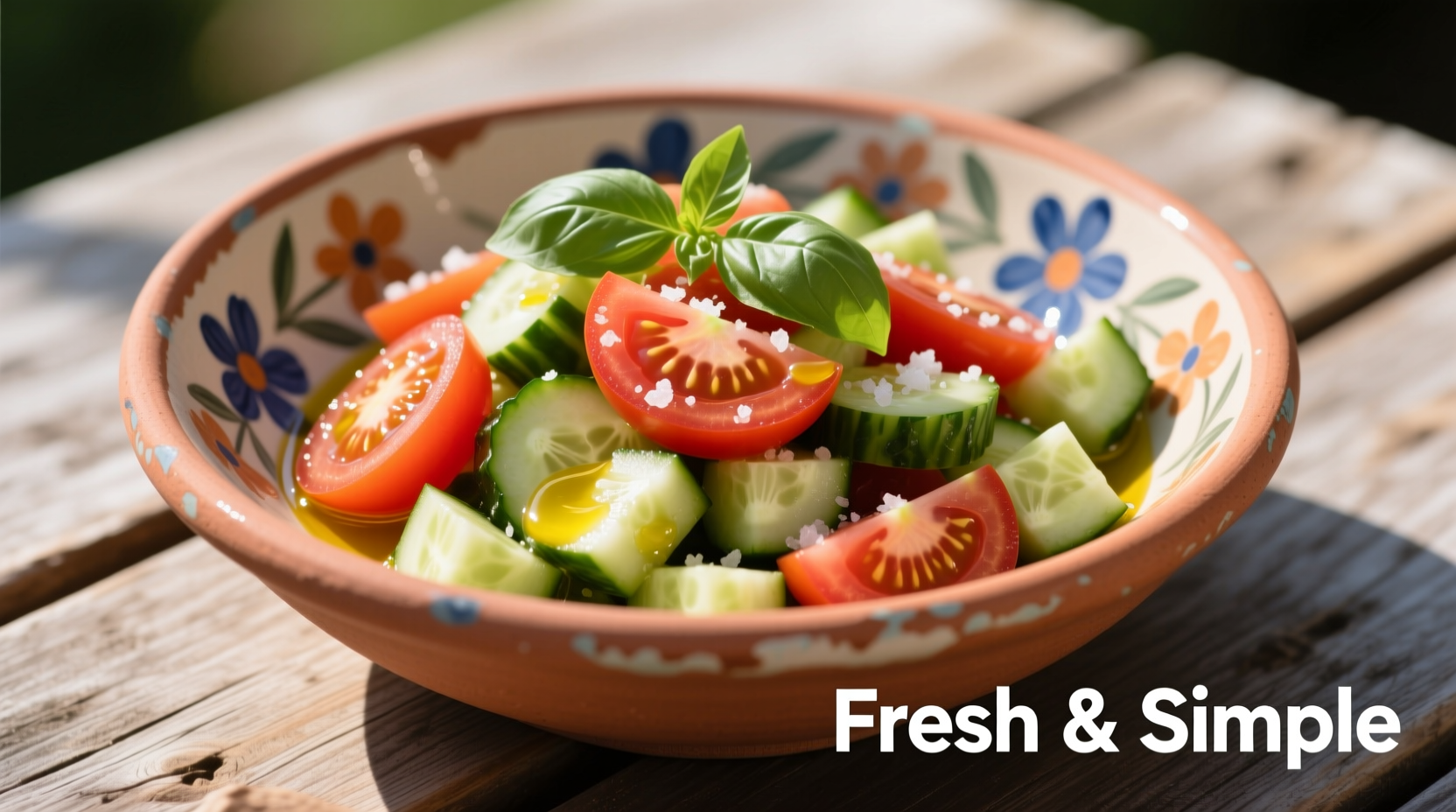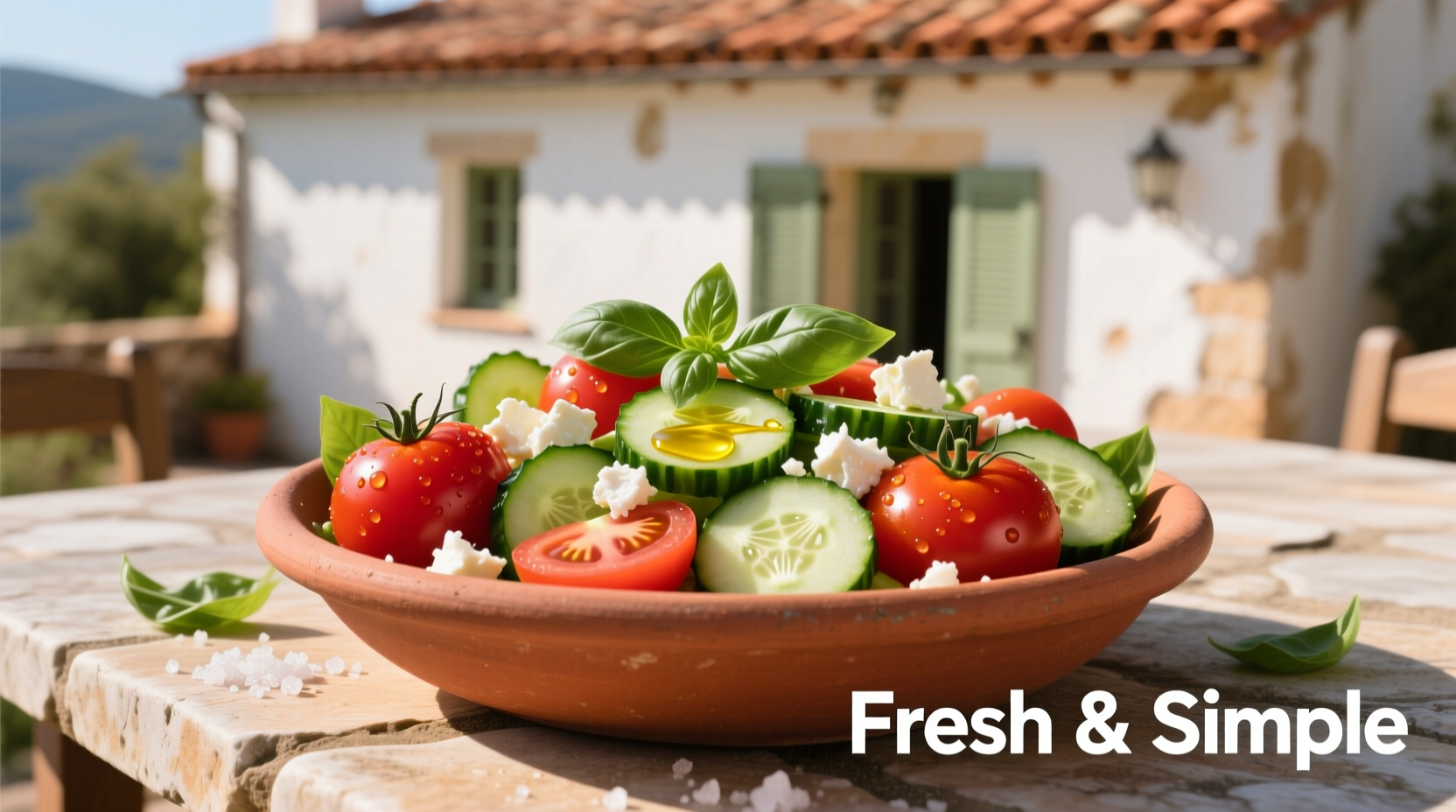Nothing captures the essence of Mediterranean eating quite like a perfectly balanced cucumber tomato salad. This refreshing dish represents the heart of Mediterranean culinary tradition—simple preparations that showcase seasonal produce at its peak. Unlike complicated recipes that require specialty ingredients, this salad celebrates what's readily available while delivering impressive nutritional benefits. Our tested method ensures crisp cucumbers that won't turn soggy, tomatoes that maintain their structure, and a dressing that enhances rather than overwhelms the fresh ingredients.
Why This Recipe Works: The Science of Perfect Texture
Most home cooks struggle with cucumber tomato salad becoming watery within minutes of preparation. The secret lies in understanding vegetable cell structure. Cucumbers contain approximately 95% water, while tomatoes contain about 94%. When cut and combined, osmosis causes water to migrate from the vegetable cells into the bowl. Our technique counters this natural process through strategic salting and timing.
| Ingredient | Traditional Preparation | Our Improved Method | Result |
|---|---|---|---|
| Cucumbers | Peeled, seeded, sliced | Unpeeled, thinly sliced, salted for 10 minutes | Retains crunch, less water release |
| Tomatoes | Chopped immediately | Halved, seeded, cut just before serving | Maintains firm texture |
| Dressing | Mixed with vegetables | Applied 5 minutes before serving | Prevents sogginess |
Authentic Mediterranean Salad Timeline: From Ancient Tradition to Modern Table
The cucumber tomato Mediterranean salad as we know it today evolved through centuries of culinary exchange across the Mediterranean basin. Historical records from the Harvard T.H. Chan School of Public Health show how trade routes shaped this simple dish:
- 8th Century BCE: Cucumbers cultivated in ancient Greece, often eaten with vinegar
- 16th Century: Tomatoes introduced to Europe from the Americas, initially considered ornamental
- 18th Century: Tomatoes gain acceptance in Mediterranean cooking, particularly in Spain and Italy
- Early 20th Century: Olive oil becomes standard dressing component as health benefits recognized
- 1950s: Feta cheese incorporated as Greek cuisine gains popularity
- Present Day: Recognized as part of the Mediterranean diet pattern linked to numerous health benefits
According to research published in the American Journal of Clinical Nutrition, the traditional Mediterranean diet pattern—which includes regular consumption of fresh vegetable salads like this one—correlates with a 25% lower risk of cardiovascular disease compared to Western dietary patterns.

Step-by-Step Preparation: The Professional Technique
Follow these precise steps for restaurant-quality results every time:
- Prepare cucumbers: Slice 2 medium cucumbers (unpeeled) into 1/8-inch rounds. Place in colander, sprinkle with 1 teaspoon salt, and let drain for 10 minutes. Rinse and pat dry.
- Prepare tomatoes: Cut 4 medium ripe tomatoes in half horizontally, squeeze gently to remove seeds, then cut into 3/4-inch chunks. Toss with 1/2 teaspoon salt.
- Combine ingredients: In large bowl, combine cucumbers, tomatoes, 1/2 cup sliced red onion, 1/2 cup pitted Kalamata olives, and 3/4 cup crumbled feta cheese.
- Make dressing: Whisk together 3 tablespoons extra-virgin olive oil, 1 1/2 tablespoons fresh lemon juice, 1 teaspoon dried oregano, and freshly ground black pepper.
- Final assembly: Drizzle dressing over salad 5 minutes before serving. Gently toss to combine. Finish with additional oregano and black pepper.
When This Salad Shines: Contextual Applications
Understanding when to serve this salad maximizes its impact. Based on culinary tradition and practical experience:
- Perfect pairing: Serves as ideal accompaniment to grilled fish, lamb, or chicken dishes (never with heavy cream sauces)
- Temperature considerations: Best served at cool room temperature (65-70°F), never chilled below 50°F which dulls flavors
- Seasonal limitations: Avoid during peak winter months when tomatoes lack flavor (December-February in Northern Hemisphere)
- Meal timing: Functions as either starter or side dish, but never as dessert component
Nutritional Powerhouse: More Than Just Refreshing
This salad delivers significant nutritional benefits beyond its refreshing taste. According to USDA FoodData Central, one serving (1 1/2 cups) provides:
- 45% of daily vitamin C needs from fresh tomatoes and lemon
- 25% of daily vitamin K from cucumbers and olive oil
- Healthy monounsaturated fats from extra-virgin olive oil
- Natural electrolytes from the combination of vegetables
- Probiotic benefits when made with traditionally aged feta
The Mediterranean diet pattern, which features dishes like this salad regularly, has been recognized by the World Health Organization as a healthy dietary model that supports longevity and reduces chronic disease risk.
Regional Variations Worth Trying
While the basic cucumber tomato Mediterranean salad remains consistent, regional adaptations add delightful variety:
- Greek horiatiki: Adds green bell pepper and capers, served with thick bread for dipping
- Turkish çoban salatası: Includes finely diced green pepper and sumac seasoning
- Spanish ensalada Mediterránea: Incorporates roasted red peppers and anchovy fillets
- Lebanese fattoush: Features toasted pita chips and sumac dressing (technically a different salad but often confused)
Storage and Freshness: Maximizing Shelf Life
Proper storage techniques maintain quality:
- Store undressed components separately in airtight containers
- Cucumbers maintain crispness for 3-4 days when stored in paper-towel lined container
- Tomatoes should never be refrigerated—store at room temperature for up to 2 days
- Assembled salad should be consumed within 2 hours for optimal texture
- Dressing can be prepared separately and stored for up to 5 days
Frequently Asked Questions
Can I make this salad ahead of time?
For best results, prepare components separately and combine just before serving. If you must prepare in advance, keep cucumbers and tomatoes separate from dressing and other ingredients, then assemble 15-20 minutes before serving.
What's the best olive oil for Mediterranean salad?
Choose extra-virgin olive oil with a fruity, grassy flavor profile. Greek or Spanish varieties work particularly well. Avoid heavily processed or refined oils which lack the complex flavor notes that enhance fresh vegetables.
How can I prevent my salad from becoming watery?
The key is proper salting and timing. Salt cucumbers separately and drain excess moisture before combining. Remove tomato seeds which contain most of the water. Apply dressing no more than 5-10 minutes before serving to maintain optimal texture.
Is feta cheese essential to authentic Mediterranean salad?
While traditional Greek versions include feta, many regional variations omit cheese. For dairy-free versions, add extra olives or a sprinkle of toasted pine nuts to maintain the satisfying mouthfeel that cheese provides.











 浙公网安备
33010002000092号
浙公网安备
33010002000092号 浙B2-20120091-4
浙B2-20120091-4